- To date, you have worked many productions, including collaboration works with people from the theater field. Having seen a lot of your choreography, it seems that there are many elements that are not what you would call dance-like. That fact makes us interested to know what led up to your entering the field of dance.
-
I grew up in the city of Takeo in Saga pref. in the south part of Japan that is famous for pottery. Nearby are the famous Arita and Imari pottery kilns. My father was a ceramics maker, and I guess that the fathers of one in every five or six families were either in ceramics or pottery. My father mostly made creative pottery and I remember playing around with the potter’s wheels when I was in elementary school. At the time I graduated from high school, we had a studio with a large gas kiln in our house, but later it was all torn down. It was too small a town to make a living with that kind of pottery.
My mother is a beautician. She helped my aunt who lived with us and ran a chain of beauty salons. There were also my two older sisters and salon helpers and interns who lived with us, so we were always an extended household of seven or eight women and just two men. My father is like a religious hermit who almost never speaks. So he was never a very father-like figure for me, and it was my aunt who ran everything in the household. - There are always a lot of female roles in the works you choreograph, and from what you have just said that might seem to be related somehow to the beauty salon. Is it that you always felt natural in an environment surround with women? Had you not yet begun dance at that time?
-
It was very strange how I got into dance. When I was a child, my eldest sister was studying Japanese traditional dance and my second sister was studying classical ballet. I was the only one who wasn’t studying anything. But my sisters often made me play the part of the partner when they practiced. In the evening after the salon was closed, they would move all the chairs aside and the salon’s mirrors would make it a natural dance studio. My sisters would always make me do the partner’s role, like when one of them was practicing to do an imitation of a pop music duo’s song and dance routine for a school festival or something. At that time, there was a band called Venus who had a popular song titled “Kiss Me on the Eyes” and all the girls would wear their hair in ponytails like the lead female vocal and imitated her sliding dance step. And they always made me be the male partner. Looking back, that beauty salon made a great dance studio.
When my second sister had her ballet lessons, I remember intentionally going to pick her up a bit early sometimes to watch the end of the practice. The girls all had leotards on and there were also men there and adults, so I remember wondering why I couldn’t do it, too. So I guess I began to get a desire to dance while watching my sisters studying Japanese dance and ballet.
And since my sisters and I were always dancing like that when I was in elementary school, people would naturally say, “Let’s have the Ide kids dance,” whenever there was a special event or festival. So, I would serve as my sisters’ partner when they gave a performance at something like a school recreation assembly. We would perform the dances just like we had practiced them in our beauty salon studio. That was how I learned to enjoy performing in front of people. The truth is that actually I am very shy by nature (laughs). So, in the course of it all I began to start thinking about what an audience would like or what would make a beautiful effect.
Our family also did a costume rental business, renting out things like kimono and other special costumes. That got me interested in costumes from an early age, too. When I use kimono in some of my works today, I still use our family’s rental goods sometimes. I wore a traditional Japanese woman’s wig in my recent piece idésolo production and it was also from my family’s shop collection. - So, although you never actually took dance lessons at a young age, you were always in a dance environment.
-
It was a beautician family where even most of our relatives were beauticians, so it was an environment where everyone expected that I would be a beautician, too. When I was growing up I felt that everyone hoped that I would be a star beautician and carry on the business. Perhaps it was partly that pressure that made me quit my beautician training soon after I graduated from high school and run off to Fukuoka where I just knocked around for a while with no real job.
Then I began to think that I would like to be a student again for a while, and I found out that there were vocational schools for dance in Tokyo. I didn’t even know such a school existed until then and I got the desire to go and see what it was like. I went to Tokyo and I entered the full-time dance course at the “Nihon Health and Sports Gakuin” in Shibuya. It was a school that had students in modern dance, jazz dance, ballet, etc. Among my upperclassmen were people like Kenshi Nomi. It was a rather exceptional school in some ways. - You studied dance formally for the first time there.
-
That’s right. It was the sort of course where you got an all-round exposure to all kinds of dance. We got full-fledged training in things like the Graham Technique. The first year was all required courses and from the second year you could start to take selective courses. At the time jazz dance and hip hop type dance were popular, but there was also a lot of modern dance and contemporary and classical ballet. There were times when I was forced to put on a leotard first thing in the morning and cry my way through ballet lessons. There were also lecture courses in the theory and history of dance. Then we would go on to jazz dance class and modern dance and English conversation and, for some reason, voice training, too. From Monday to Friday we were dancing every day from morning until evening. Our visiting lecturers included people like the ballet choreographer Tatsuo Mochizuki and the critic Roku Hasegawa as well as many foreign lecturers from places like the British Royal Ballet and Rosas.
What I thought interesting at the time was that there was a full month of summer vacation and as soon as vacation started after all that time of dancing all day, we would immediately put on weight. Not just me but all the women, everyone. Then, when we got back to school and on the same schedule again our weight would come back down within a month. It may have been partly because we were young, but the program was hard enough that we would lose as much as 10 kg in three or four weeks. And that is also why we would fall asleep during the classroom lectures. And again, it was an almost all-girl environment for me, with about 25 or 26 women and maybe one or two men. Some of the men also quit in the second year, so I can tell you that I stood out (laughs).
At the school we also had performance sessions once a month. For those we had to decide on titles for our works and names for our dance groups. We had a modern dance class with a foreign instructor and the performance I did in a Caribbean dance style went over well for some reason. After that the instructor told me, “Yours not Caribbean, yours Idebbean.” So I made our group name “IDEVIAN.”
Anyway, we really danced hard for those two years of dance school. I don’t mean to brag, but I did well in my grades, too. I was class representative in my second year and I became the leader of our graduation performance, so I was always in a position of leadership. - Then, did your classmates become the members of IDEVIAN?
- Yes. Today, four or five of those original members remain with me. But, most of the people I graduated with eventually gave up dance and got married. I don’t think there are many who are still dancing today.
- What kind of choreography did you do in those two years? What kinds of works did you do?
-
We were performing once a month, so I made a lot of works during that time. One of those was the
Idebbean
piece. It was a strangely choreographed piece that really went over well for some reason. Really got into choreographing that piece and the experience made me want to try to create more works. It had been a play on Caribbean dance and in one sense, that work started me on a direction that you might call parody. For example, it happened to be the time of the Lillehammer Winter Olympics, so I did a work called
Idehammer
, and Pina Bausch was popular at the time, so I did an
Ide Bausch
piece, too. There was an
Idelliam Forsythe
and an
Ide Kylian
. I just put Ide on everything (laughs). But, it wasn’t just out of playfulness or parody. I wanted to use those names also because they weren’t well enough known in Japan at the time. Some students might get free group tickets from the school to things like a Pina [Bausch] performance in Tokyo but they wouldn’t even go to see it. I thought that was a waste, so I would get the extra tickets and go to see all the performances I could.
From that time, I was doing mostly choreography and I wouldn’t perform [as a dancer] in the works myself. You might say that I wasn’t really interested in doing the dancing itself. I would dance hard and seriously in class, and I think I did well—and was about 10 kg lighter than I am now. But at the same time, I was in a position of leadership, where I had to hold get the performances together for a number of different groups of students. To tell the truth, I often just didn’t have the energy left over to take part as a dancer, too. - Having to choreograph a piece a month is certainly not an easy thing to do. Considering the fact that, unlike just doing the dancing, you have to be aware of the entire picture, from the space to the music and the overall concept.
-
We had a large studio with simple lighting capabilities, but in the end it was just studio performances for our own [school] audience. Every month we would have a different teacher, like there was a “Performing Arts” class and the teacher would introduce us to a new method and then say, “Now you [students] try doing the choreography.” That was the kind of classes we had, and although our performances were not given for the public, there were some that I think were good enough to have held before a public audience.
Perhaps it is fate that I ended up in such an environment, but in time the teachers would be saying, “… and in this part, why don’t we add some of your strange Ide movement to the choreography.” So, then I would be consulting with them on how to do that. It became a weird environment where sometimes I didn’t know if I was a student or an advisor. And, since I was doing choreography for the other dancers like that almost from the beginning, I guess I got used to choreographing. I think I liked the directing aspect from early on. In the end I completed the full two-year course of study, and I think that is something that doesn’t happen unless you enjoy going to class every day and experiencing a lot of things. - When you graduated, did you think that you wanted to continue in dance as a career?
-
My parents asked me what I was going to do after I graduated and I decided that I would stay on in Tokyo and continue dance for a while, supporting myself with part-time jobs. After I graduated, the school asked me to come in from time to time as a substitute instructor. I can’t remember now what I taught, though.
Besides that, I started taking lessons that appealed to me, like those at the dance studio of Asako Ogawa and other former graduates of our school that I heard about. I also danced in special performances at the Kagurazaka Session House in Tokyo. I also happened to meet Ryohei Kondo just about the time I graduated. He was doing modern dance with a student circle at Waseda Univ. that I heard was interesting, so I went to see. I met him and we became friends, and after that I started dancing with the Waseda modern dance circle. It happens that Ryohei wasn’t originally from Waseda either. It turned out that just about that time an invitation came for us to perform at a university student dance festival being held in Germany, so we decided to go. It was Ryohei and me and about seven others and Sadayuki Hayashi of the Golgi Worx Company was the director. - Was that the first performance you danced in outside of school?
-
It was. It was my memorable first [public] performance. And, the fact that I was able to participate in this kind of performance right at the time of graduation gave me delusions that I would be able to continue dancing like that (laughs).
I haven’t said this yet, but for the first three years out of school I continued as a dancer like this. I would perform at special events when they came along, and during that period I began to compile a group of small works that I had choreographed.
At the time, there was sort of philanthropic program called “Dance Theater 21” that allowed dancers or groups to rent out the Kagurazaka Session House in Tokyo at a low price beginning at 9:00 at night, after regular theater hours. A plan came together to present a kind of omnibus of my works there. For that inaugural performance we changed our group name to IDEVIAN Crew on Friday the 13th of January 1995, and did a production of my work titled IDEVIAN . - Looking back, that work IDEVIAN certainly seems to contain a lot of the essence of the Ide style. And, for a debut work it was certainly one that involved a lot of dancers. How many people danced in that work?
- It was 25 or 26 people, mostly fellow students from our school. And to tell the truth, the reason I decided to do this work was to put a period on my career in dance. I intended to quit dance completely after that production. It was like a graduation performance for our IDEVIAN group (formed in 1991) that had been together since our school days. So I wanted it to be a big commemorative production, after which I would call it quits. But, just after that, an invitation came for us to perform it again at the Arena Fes 95 in Erlangen, Germany. Although we had to pay our own way, we decided to go with the performance as an excuse for a trip to Europe. By that time I was beginning to feel, “Hey, this is making it harder and harder to quit!” (laughs)
- Since then, you began introducing new works at a pace of about one or two a year, and four years after launching IDEVIAN Crew you put on a big production of Coppelia at the Setagaya Public Theatre.
-
I chose
Coppelia
because up until then I had always wanted to do a ballet work. The Park Tower Hall is more of a hall than a theater, but the Setagaya Public Theatre is a traditional proscenium theater, so I wanted to use it to do a large production in the classic sense. I had taken ballet lessons as a student and I liked Tchaikovsky.
The story of Coppelia is a rather simple one, but the music is great. I am not very good at working a storyline into my works anyway, so with this production I just wanted to enjoy moving to the music. When you listen to that kind of repetitive music, it can build a sense of fear. So, I thought things like, “Wouldn’t it be interesting if a dancer like Toru Iwashita came on stage at that point?” Although I say the story is rather simple, as long as we were to do a production of Coppelia I believed that we had to stick to the storyline. My image was that if we kept to a basic condensed version of the story, it would then be all right to concentrate on enjoying the dance element. Although the aim wasn’t gymnastic precision, I believe that the group dance sections were carefully choreographed. For that production we added three new members and we approached the work from a completely different direction from what we had done until then. Still, it didn’t take long for the choreography and composition to come together. Rather, we took more time to work out the non-dance aspects like how to use the music and the arrangement of its pieces. - The movement that came out in that work had a “dancy” nature but the movement you choreographed was very different from any movement of conventional modern dance. The formations that the dancers come onto stage and leave the stage with are very intricately composed. What I admire about your work is that no matter how well received a particular work might be, you never cling to that success but always do something completely different in your next work. The work Fuicchi (Discord) that you introduced in 2000 at the Park Tower Hall was again completely different in content.
-
I believed the great Nostradamus foretold that the world would be destroyed in 1999, and I believed that I would die then, too. I choreographed
Discord
as a memorial work for my own funeral. But 1999 came and went with no Armageddon, but we decided to go ahead with the funeral anyway. Also, I had always wanted to do a dance on tatami. So, for this work we covered the entire dance floor in tatami instead of linoleum. For the background we hung the black and white curtains they use for funerals in Japan, and all the dancers wore mourning black. Since it was my own funeral, I appeared too as one of the dancers. The message was “Let’s make this the end.” There was also something that intrigued me about the counseling term
seikaku no fuicchi
(discord of character [between people]) and I had always wanted to do a work with Discord as the title. So that title was decided from the beginning.
Another element of the background behind this work is that I had a strong desire to use Latin music. I have always liked Latin music. I want to listen to all the music I like, and if I am going to perform to it, I want the whole piece to be gone to a single type of music I like. But, when we tried it we found that doing the whole thing to Latin music was a bit strained, so we worked in a couple of sections of contemporary music. We also used and Astor Piazzolla tango piece. - There was another big change seen in the work Unspoken Agreement you performed with Diversions in Britain (Jan. 2002) where there was a feeling that you had discarded any type of storyline or meaning and focused purely on “dancing.” How was it that you came to work with Diversions?
-
Diversions is a resident dance company in Wales, and they have long had a policy of calling in outside choreographers to do works for their repertoire. It seems that at a time when Diversion was looking for a choreographer, they happened to see a video of
Discord
at the booth of Japan’s Saison Foundation at some performing arts market. They thought it was interesting and I was asked at first if I would like to dance in Wales. When I sent a reply that I was working as a choreographer, not a dancer, I got an invitation from the producer saying that I was welcome either as a choreographer or a dancer. That decided it.
A choreographed a work for them that I titled Anmoku no Ryokai (tacit understanding) but the English title became Unspoken Agreement and I didn’t quite get a clear feeling from it. At that time I decided that I had to do a production of the work in Japan. I don’t know why but I have this thing about titles. When I create a work, I always have a title in mind before I begin. For example, when I see a word like chochin that is written in the Japanese hiragana syllabary characters, those characters seem to be moving to me. I am Japanese down to the core, but I like undulations and the nuances and shapes of written characters seem to me to take on an aspect of motion. I also like resonance. It’s not like I get inebriated on them though (laughs). Anyway, in April of 2002 I did a production titled “IDEVIAN LIVE FIVE – Anmoku no Ryokai Part 2 ” (Tokyo, Morishita Studio). - In Wales you were choreographing for people of a completely different life environment, but I felt that contrasts and integration of the solo and duo, and group dancing went extremely well. I felt that you were playing very close attention to the composition of the flow of time and space and the variations in the entrances and departures of the dancers and how they were positioned on the stage.
-
I am often told that. There are some details to which I pay a lot of attention, but in general don’t worry about minute detail. The choreographing itself goes quite quickly. Often it comes together right away. First of all, I set the basic composition, and then I start to add detail changes. Often I will add a mix of various modifications later on.
At the time I was working with Diversion, I was also doing choreographing for theater and I was used to working with actors on their movements. So, it actually required a lot of courage on my part to be working with professional dancers like the Diversion people. These are people who have been dancing since they were children and they really work hard. They are always moving and sometimes you just have to tell them to take a rest or they won’t stop. Also they had a tendency to try to make “dance” out of everything I choreographed for them. Naturally, they weren’t used to the kind of movement I choreograph, so everything becomes dance-like. I hated that, so every day was a battle for me. An interpreter was only available about once a week, so the rest of the time I had to do my best to communicate with a dictionary in one hand.
In Wales, I first did a one-week workshop in May 2001, and then I went back again from December into January. In December I had them show me their interpretation of what I had choreographed and after that it was a process of breaking down what they had done. The basic composition of the work had been completed in about two weeks.
In the end I think it came together as a fairly appealing work. But, I prefer movement where the dancer’s center of gravity is kept lower, something like Noh movement but perhaps not to that extreme. In contrast, Western dancers tend to want to keep the hips higher and center of gravity up. I don’t feel comfortable with that kind of movement. For better or worse, everything they do naturally becomes “dancy” in my eyes. I felt that they didn’t have a knack for the smaller movements I wanted. That is probably a matter of environment to a large degree, but they seem to be used to larger movements that look almost like over-action in my eyes. So it was hard for me to communicate the kind of minimal movement I wanted.
I am often attracted to the everyday “gestures” or the “habitual movements” people have and I find choreography in those movements. But, small gestures that Japanese audiences appreciate, for example, don’t get a response in other countries. On the other hand, I find that I can work in places like Britain and Germany by asking what kinds of gestures or movements people use in specific situations and then find ones that are similar to the ones we use in Japan.
Speaking of gestures, I have always loved watching people since I was a child. Partly because there were a lot of women in our household, there were always people coming and going. So, for some reason, there were always a lot of people around. I have always liked just sitting alone and watching. And, when I watch people, I begin to see their [habitual] movements. Like spirits in the background. Don’t you get the feeling sometimes?
So, even with people I am meeting for the first time, I can put together images of what movements are interesting with a particular person. In my dance school days I was the class representative and I got used to directing large groups of people. At the time I was responsible for organizing the activities of about 150 young women. - When I saw Les Liaisons Deluxes , I got the feeling that you were boldly attempting things that you hadn’t been able to do with Diversions. In short, you used a very Japanese theme and the movement was also very detailed and theatrical in a Japanese way I thought those elements were also very well matched with the Bach harpsichord concerto music you used. It was also interesting how you created a sense of instability by using a slanted stage floor.
-
That came from a desire I had for some time to lay the linoleum floor on a slant. And, previous to that work I had done a workshop at YCAM in Yamaguchi where I choreographed a piece for that kind of slanted stage for a group of participants from the general public with the purpose of having them give a dance performance. From that time, I had the desire to do a more concentrated version of the same thing for a formal IDEVIAN Crew production.
I had already decided on the title Les Liaisons Deluxes and I believed that some Baroque music like harpsichord would make it especially strong. That was the first time that I had ever used that much Baroque music. There is something subtle and byzantine about harpsichord music. My favorite is Bach’s Concerto for Four Harpsichords (in A Minor), but the more I studied the music the more I felt that the music gets stronger when the number of harpsichords is reduced to three and then two.
I composed this piece to begin with small movements within a triangular space and then expand outward from there. And I thought that it would be funny if everyone were like the family members in the Japanese cartoon Sazae-san . So I had the costumes look a little old-fashioned and created the atmosphere of what might be a typical port town household where there is a Western style chandelier but it is still a Japanese house with tatami flooring. I wanted it to have the feeling a salaried worker’s family with interests that leaned more toward Europe than the U.S. I thought it would be more interesting if the father had an image that was not quite the perfect father, so I used the actor Arata Saeki instead of a dancer. - The miss-match between the gorgeous chandelier hanging out of place above the unexceptional family was effective. In contrast, your 2005 work Take A Roundabout Way, Pls was a very unique composition. I am sure that you had a clear concept for the work in your mind, but it was hard for me to see.
-
A concept? I’m sorry but I don’t know if there was one at all (laughs). Speaking in specific terms, I had heard that they were going to close the Park Tower Hall, so I thought I would do something had long wanted to do: a work using a long, narrow stage. In this work, the dancers in boy/girl scout type costumes move back and forth along this one lateral line of stage. At first I was thinking of having them all dresses as policewomen. Then we could use the “take a detour (roundabout way), please” phrase naturally.
But, then I thought that would make it too obvious, and then I got the idea to use scout uniforms from the Girl Scout house near where I live. So, we made these uniforms with a red stripe in them, and when we got them on stage and the lighting turned red, they took on a military look. That was something I hadn’t anticipated, but other people also said they saw war imagery in it. When I describe it like this, it does sound a little bit like a concept (laughs). - Outside the dance field, you have done a lot of collaborations with theater people, haven’t you?
- To tell the truth, I do theater choreography without knowing the specifics of the story. I intentionally avoid reading the script, because if I do I find it difficult to choreograph. I just start with a general feeling for the atmosphere and what has happened up until the start of the dance section. I don’t want it to stand out as a separate piece inserted in the middle of the play. I want it to feel natural. And to make sure that doesn’t stand out as something of a different nature, I use lots of everyday movements. I think of things that will blend in well with the flow of the play.
- 2005 marks the 10th year that you have been working as the IDEVIAN Crew.
-
Yes. In recent years I have not been dancing in my own works, but to commemorate the 10th anniversary, I said that I would begin dancing in them again, beginning with
Take A Roundabout Way, Pls
. I also did
idésolo
in answer to a 3-year-old request to do a solo work. The career method I have followed until recently has been to concentrate on choreographing a variety of different works rather than dancing myself, but I wanted to make 2005 a different year. But, this doesn’t mean that I am going to continue to dance like I did last year.
As for idésolo , I decided that since it was a solo, I didn’t have to do much thinking for the work. My approach was sort of like showing myself just as I am, like a guinea pig, and if people enjoyed coming to see that, that was good enough for me. I guess I wasn’t thinking very deeply in terms of a specific theme like I do with IDEVIAN Crew productions. - What plans do you have for the future?
-
In September 2006, I am choreographing a new work for IDEVIAN Crew. We will perform at the Setagata Public Theatre. I am looking forward to it.
I also want very much to do some serious studying again. It may sound strange, but I have the desire to be bound to something, like a student bound to the requirements of a course. I am wondering if there isn’t someplace overseas where I could go to study, not as a dancer but as a choreographer. When I was younger I used to go off to Europe with just one backpack but I haven’t been able to do that since I started working with IDEVIAN crew and choreographing for theater. For example, I’d like to go to Hawaii and study hula dancing. Hula dancing actually has a sort of masculine and violent strength of movement. I want to study the kinds of spiritual dances where every word and movement has meaning, like something danced before the gods. Or, maybe it is just that I want to get away from Japan for a while …
Shigehiro Ide
Inside the mind of Shigehiro Ide, a unique talent of the contemporary dance world
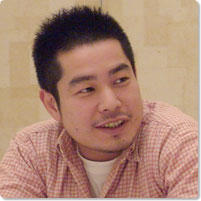
Shigehiro Ide
Shigehiro Ide is head of the dance company IDEVIAN Crew, which he founded in 1995 and has continued to give performances with both in Japan and abroad. His choreography is recognized for its combination of everyday gestures and movement that takes advantage of the individuality of the dancers involved plus the originality of the group dancing it employs. His works involve collaborations with artists from other fields, such as the contemporary artists Noboru Tsubaki and the musician ASA-CHANG. Recently he has also won acclaim for his choreography for a large number of theater works and musicals, such as AMERIKA (directed by Osamu Matsumoto), Lulu (directed by Akira Shirai) and Letter from Claudia (directed by Tatsuo Kaneshita). In 2004, he was awarded the Outstanding Staff Award of the Yomiuri Theater Grand Prix awards.
Interviewer: Tatsuro Ishii
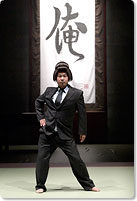
idésolo
(2005)
©days
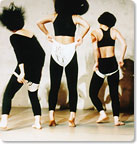
IDEVIAN
(1995)
©days
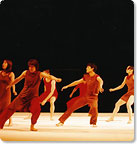
Coppelia
(1999)
©days
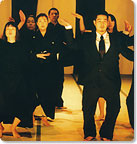
Fuicchi (Discord)
(2000)
©days
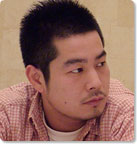
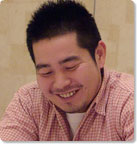
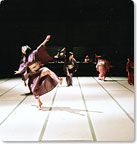
LIVE FIVE – Anmoku no Ryokai Part 2
(2002)
©days
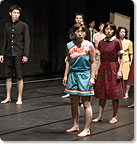
Les Liaisons Deluxes
(2004)
©days
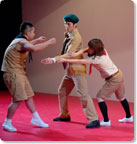
Take A Roundabout Way, Pls
(2005)
©days

